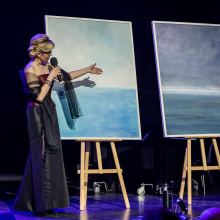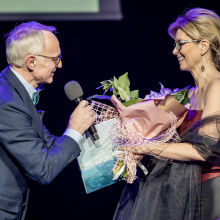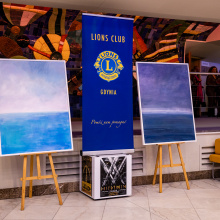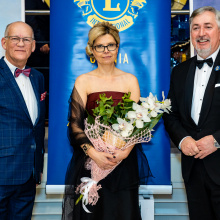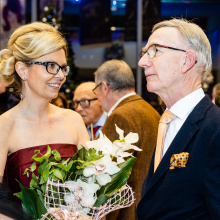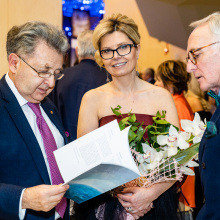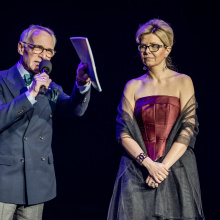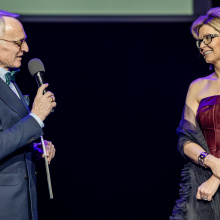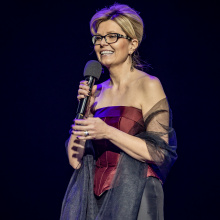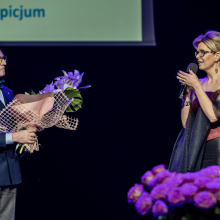Paintings depicting the Baltic Sea by night and by day were put up for a charity auction by the Lions Club Gdynia. On January 6, their author - UG Vice Chancellor for Information, Communication and Promotion dr hab. inż Aneta Oniszczuk-Jastrząbek, prof. UG - presented her works during the charity New Year's Eve Encore Concert at the Danuta Baduszkowa Music Theatre in Gdynia.
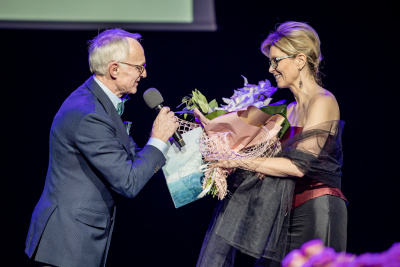
New Year's Eve Encore Concert. Leszek Fiertek and prof. Aneta Oniszczuk-Jastrząbek. Photo by Alan Stocki
The initiative was suggested by UG Deputy Chancellor for Administration and Innovation Leszek Fiertek, a member of the Lions Club Gdynia. - 'I agreed without hesitation because the aim is very noble,' says prof. Aneta Oniszczuk-Jastrząbek, 'I chose the sea as the theme of the painting because of its symbolic value. I chose the sea as the theme of the painting because of its symbolic value. Some say, "a sea of opportunities", and it is also at the sea that one can best see the horizon, from which dawn rises every day.'
The main aim of the Lions Club concert and auction is to purchase an ambulance for the St Lawrence Children's Hospice House 'Bursztynowa Przystań' in Gdynia. The philanthropic organisation also plans to use the collected donations to continue its existing aid and international charity projects. The auction is open to Lions Club members only.
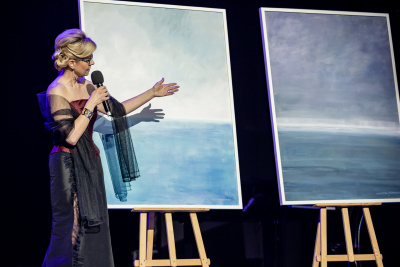
fot. Alan Stocki
- 'I painted the sea at night and during the day. Together, these two paintings are meant to remind us that after every darkness comes a dawn that brings with it hope for a better tomorrow. In this case, the dawn is the Lions Club initiative that will create a sea of opportunities and hope for the children of the hospice.'
The exhibition 'SEA-EU by the SEA', also by prof. Oniszczuk is currently on display at the University of Gdańsk Main Library.
Prof. Aneta Oniszczuk-Jastrząbek talked more about her work in an interview with Gazeta Uniwersytecka conducted by Sylwia Dudkowska-Kafar (nr 10, 2022) :
- Can economics and painting be reconciled?
- The part of my life I devote to economics is not visible in the pictures I paint. Nevertheless, my professional work is an inspiration. It's all about the idea of combining these two worlds and using your imagination in the process. They work wonderfully together. I hope that the exhibition shows this.
- During the opening, you mentioned that painting and sketching have always come easily to you, but that you started painting seriously in 2012 after you had already obtained your PhD. Can you imagine becoming a painter rather than an economist?
- No. Painting has always been a passion, an important but additional element in my life, often accompanying me during important moments. I never wanted to focus only on art. I never considered developing professionally in this direction. There was no need for it because my current job also gives me a lot of satisfaction and professional fulfilment. At the same time, I can't imagine that this second sphere of my life would suddenly be missing. It is my springboard and my sanctuary.
- You are inspired by contemporary painting, which draws on various techniques and has abstraction and minimalism at its core. What is your development path as a painter?
- I used to have absolutely no interest in painting, but I enjoyed painting, drawing and sketching. As you already mentioned, these activities always came easily to me. However, it wasn't until I finished writing my postdoc book that I decided it was time for me to take my passion more seriously. It was then that a friend took me to a workshop at Agnieszka Olędzka's Color Spa, and there I came into contact with professional painting, various techniques and styles. However, it is difficult to find any particular direction in my painting, as I do not follow any particular style. I paint the way I feel and what I want to get out of myself at the moment. I do not rely on literalism but on abstractionism and minimalism. I want to convey emotion and give joy through my paintings. This is the most important thing for me.
- You head the Department of Transport and Maritime Trade of the Faculty of Economics at UG. You have served as Vice-Rector of our university from 2019 to 2020, as Director of the UG Centre for Communication and Promotion from 2020, and currently as Deputy Chancellor. In addition, you are a member of many scientific societies and a participant in numerous EU and international scientific programmes. How do you reconcile the enormity of your professional duties, the stress of your position and managing many teams, with your passion for creation, for which you need a clear mind?
- If you love doing something, you will always find time for the passion associated with it. For me, as I said, art is a break from my professional work. I go into the studio and completely switch off. I leave the stresses and problems of everyday life outside the door. In this way, I can isolate myself for two or three hours. I most often paint at weekends. If I know that Saturday is a day off, I start as early as Friday afternoon. However, I don't create regularly, I don't paint every week. I just have to feel the need to paint. I am in such a good position that I don't create under any pressure, but when I want and need to. There comes a point when I start thinking about it constantly. Then I stand in front of my easel and paint for a few hours. Of course, that doesn't mean that I paint a picture during that time.
- Approximately how long does it take to paint one picture?
- I will answer with a concrete example. You have certainly seen the painting Grande Palace at night. This painting, which is a memory from Brussels, I painted for about twenty hours. With breaks, of course. It is incredibly precise and meticulous. I was very keen to show the architecture of this old town, to capture as much detail as possible. The second painting is from the same city: Brussels in the rain I painted for two hours. The day it depicts was very intense professionally. Full of rain, meetings and rushing around. It's not that every painting is painted the same way. Sometimes I transfer the mood I was in at the time onto the canvas. When I paint, the places that I remember under the influence of a particular impression are important to me and the frames that delight me are important. The emotions of everyday life did not matter, but those of my travels did. I recalled everything by looking at the photographs of these places, recreated the atmosphere and the vibe, added my own reflection and poured it all onto canvas. I wanted to show how I felt about a place.
- Which of these paintings is closest to you?
- I can't pinpoint just one painting. Each of my trips to the project partners' cities had different experiences of the adventures I had and the people who accompanied me. Let me repeat what has already been written in the catalogue presenting my work: 'I flew to Brussels with Rector Piotr Stepnowski and student Jan Szczepanik. I walked the narrow streets of Cadiz with Ewa Weronis, Marlena Rutkowska-Myzyk and the late Kamila Chomicz-Sokołowska. I visited Split with Magdalena Nieczuja-Goniszewska and Monika Zdroik, and my husband Tomasz took me on a trip to Malta'. This mix of different personalities was not insignificant. Each of these trips was different, unique and equally important. This obviously had an impact on how I experienced it. In fact, this is also why the paintings were created. Thus, there is no single trip that stands out at the expense of the others. And for this reason, I cannot single out any one painting.
- If I were to answer this question, having experienced the emotions that you convey through your paintings, I would say that the landscape from Cadiz, Vinedo meaning vineyard, is the one that stuck out strongest in my memory...
- This is the painting that my husband refused to let me pull off the wall [laughs]. It depicts the Andalusian horizon and you can actually gaze at it. I wanted everyone who would look at my paintings to find something personal in them. Take, for example, the painting The Door from Malta and the dog disappearing behind it. Everyone can perceive it differently. Some will wonder what story this old house hides, others will pay attention to the dog or the details.
- How did you come up with the idea for such an exhibition?
- I started thinking about it even before I went to Brussels in November 2019. Before that, on the first of October 2019, I took up my position as Vice-Rector and received the project proposal European University of the Seas - SEA EU (2019-2022). I had been organising this project from the very beginning and the more I read about it, the more I talked about it and the more meetings I had about it, the more interesting it seemed. One day the thought came to me that it would be great to show the twin towns in a different, unobvious and unorthodox way. I wanted to show them through my eyes. The common point of each town, as in the project, was to be the sea. However, before I decided to take on this challenge, I went through a long thought process. I knew how much work it would cost me. I assumed that I would visit each city and illustrate each with two paintings. It was going to be six trips, including Brussels. I was going to experience these places and pour these experiences onto canvas. At the time, the idea seemed crazy, but once it germinated in my head, there was virtually no turning back. I couldn't get away from it anymore. Then we went to Brussels and I saw all these places that delighted me. I wanted to immortalise them. Then I went to Cadiz and there I marvelled at a woman dancing flamenco in front of a restaurant or the orange trees growing almost straight out of the pavements in the middle of the old town. I became more and more convinced that this project was special, that these places and experiences were worth remembering and encapsulating in an image. All of these coastal towns, although they share a coastal climate, are incredibly diverse. And I also wanted to show this diversity and beauty. As I mentioned, I knew how much work this would cost me. However, I could already see myself at the easel, I had ideas for the paintings. These thoughts were so intrusive that I decided to give in to them. I started to organise everything. Which wasn't so easy, because the sub-images and canvases themselves have to be specially imported. They are made to order in Czersk. The canvas is lined with linen. I couldn't just go to a shop, buy a canvas and start painting. I had to organise the right materials and reconcile this challenge with my professional and family life. In retrospect, however, I can see that the hardest thing was the decision itself. It was a pleasure to paint these pictures.
- How did you select the composition for the paintings?
- As I said, the premise of the whole project was that there were to be two paintings from each location. I chose scenes that caught my attention and made an impression on me. Places where I experienced something interesting. The environment, the atmosphere, the colours and the situation had to grab me and provoke some kind of reflection. I took a lot of pictures, which I then used.
- I recall your description in the catalogue of the circumstances in which you created the painting Grande Palace at night. The idea for it came to you when, in the evening in Brussels, you were looking for a hotel in the Old Town and, turning right from a street, you almost bumped into a mountain of starry diamonds, which was in fact a row of richly inlaid and illuminated townhouses on the square in question.
- Exactly. These are the very memories I wanted to capture. As for the painting entitled Vinedo, meaning vineyard, which you liked so much, the idea for it came when, on our second day in Cadiz, the organisers of the project meetings at the local university took us to a campus a few kilometres away from Cadiz. Once there, we were invited to visit a beautiful vineyard which, as I said earlier, offered a magnificent view of the beautiful Andalusian countryside as far as the eye could see. I marvelled at both the vineyard and the landscape. I knew I had to immortalise them. Similarly, during my walks in Malta, I was in awe of the colourful balconies and doors. These are characteristic elements of Malta. They come in different colours, maroon, blue, green and navy. They delight. They are such colourful gateways to no less beautiful buildings. Most often they lead into a lovely courtyard. Often such doors have carved handles and knockers. Here, too, I was enthralled by the landscape and history, but I also paid attention to these details that completed the whole. And it was these details so characteristic of Malta that I wanted to show.
- The paintings were created systematically after each trip?
- That would have been unfeasible. We went to Brussels around the seventh of November and Cadiz on the eighteenth. In just over a week I would not have had time to paint two paintings. When the pandemic started in 2020 and it was not possible to go anywhere, I had a break and more time to paint. At the same time, because of the pandemic restrictions, I was unable to travel to Kiel and Brest. These cities are still waiting to be captured on canvas. I assumed, however, that I would dedicate three years to this challenge. Travelling and painting. I think now is the time for further artistic challenges.
- Such as?
- I have always wanted to learn to dance the tango [laughs]. New experiences are very important to me. These, in addition to my professional work, give me pleasure and replenish me internally. It is very important for me to transmit positive energy to people. After all, that's what enjoying life is all about. I teach this to my daughter. She is also experimenting a bit with painting.
- What does your family think of the free time you devote to painting instead of them?
- In the case of this challenge for the exhibition 'SEA EU by the Sea', they have shown great patience. After all, I was almost inaccessible to the world during those moments when I was painting. I locked myself in the studio and they embraced this world on their own. They know that I love it, and they let me realise it.
- Rector Stepnowski recalled at the vernissage that the past few years of collaboration on the SEA-EU project have been an extraordinary experience of getting to know many different academic communities. These acquaintances, journeys and memories have translated into an extraordinary series of your works, which make us realise that in addition to their academic work, academics also fulfil themselves in their private hobbies. Sometimes art also becomes a kind of story about how we perceive the tasks we carry out in our professional work. Multifaceted and beautiful projects emerge from this combination. In the aforementioned academic environment in Poland and abroad, have you met other people with such successes?
- The first that comes to mind is of course our rector, Professor Piotr Stepnowski, who sculpts in wood.
- There are also two paintings from Gdańsk in the exhibition: the melancholic Baltic - our sea, and the strong Gdańsk - the city of cranes. I was recently at the National Museum for an exhibition of Fangor's work and this last painting of Gdańsk reminded me of the painting of the Palace of Culture from 1953, which was created after Stalin's death. In this painting, the Palace of Culture is inverted and, together with the cranes sticking out of it, it is embedded in the old architectural fabric of Warsaw, which gives a rich field for interpretation. Your painting Gdańsk - City of Cranes was created in 2020 during the protests of students who opposed the Constitutional Court's verdict on abortion. Do you still have paintings in your portfolio that were created under the influence of important social events?
- This is the only such painting. Protests by students who fought for the freedom of speech, freedom of expression and their rights are written into the DNA of our university. The moment the verdict was announced, students took to the streets all on their own. UG students were probably among the first in Poland to start protesting. There were huge emotions. Negative ones, but also ones that gave the feeling that young people are not indifferent to what is happening and that they can unite. Young people know what they want to achieve. This bodes well for the future. And the University of Gdańsk is an open place. This is very important to me. We don't close ourselves off from these young people. We support them. Students in Gdańsk fought for their rights in the past and will fight in 2020. Hence this image of Gdańsk, which is after all a city of freedom and Solidarity. Those cranes you see in the painting were, indeed, witnesses to the victorious struggle for freedom of speech and beliefs.
- Which artists inspire you the most and why?
- Certainly contemporary painters such as Teresa Pągowska-Tomaszewska, Marek Wróbel and Beata Polak-Pela. Encounters with the latter have had a huge impact on my painterly perception of reality.
- Why contemporary painting?
- I don't like realism and on my canvases, I don't paint reality as it is, but as I see it. A subjective interpretation. Contemporary painting breaks away from patterns and forces you to think. At the same time, it is often minimalist. Every artist has a style and tries to find it. I don't really consider myself an artist. I don't paint my pictures to sell them. It is simply my passion.
- And would you agree to the exhibition being shown in the other twin towns?
- If I am offered such opportunities, I would have no objection to my paintings going there.
- I'm sure you have more of them at home. Is there a favourite painting among them?
- Yes. It's a series of paintings from a trip to New Zealand.
- How long did the preparations for the exhibition itself take? I know that you were actively involved in what it should look like. Did you have a vision of how to show the paintings from the beginning, or did you rely on the curators of the exhibition, namely Marta Szaszkiewicz and Joanna Kamień?
- We worked together. We discussed most things together. These are two wonderful women and I think we were on the same wavelength. We understood each other's ideas on the fly. There were no misunderstandings or conflicts. We had a common vision. When we enter the exhibition hall, we are surrounded by white everywhere. Even the picture frames are white. The partner cities almost stand out from these frames and these walls. The idea was to show the character of these places. It is these paintings, the colours and my experiences that are supposed to bring them to life. I hope this has been successful.
- What are you currently painting?
- I am currently working on a painting that depicts a container ship sailing. Maritime transport has accompanied man for centuries. Container ships themselves grew in importance as trade expanded. Today they sail all over the world. They cover thousands of nautical miles. They are diverse; smaller, larger and those quite grand. I decided to paint one of them because I was enthralled by the colours of these ships. When I paint, I juxtapose different colours, in this case, the different colours of the containers themselves. They often don't match, because nobody in the port thinks about how to colour-match them. And yet, if we take a painterly look at such an in-sail, loaded container ship, everything in it harmonises against the sea. Painting these small and colourful squares and rectangles gives me a lot of joy [laughs].
- Thank you for the interview and I wish that this joy will be as much as possible in your further work.
- Thank you.
Sylwia Dudkowska-Kafar

